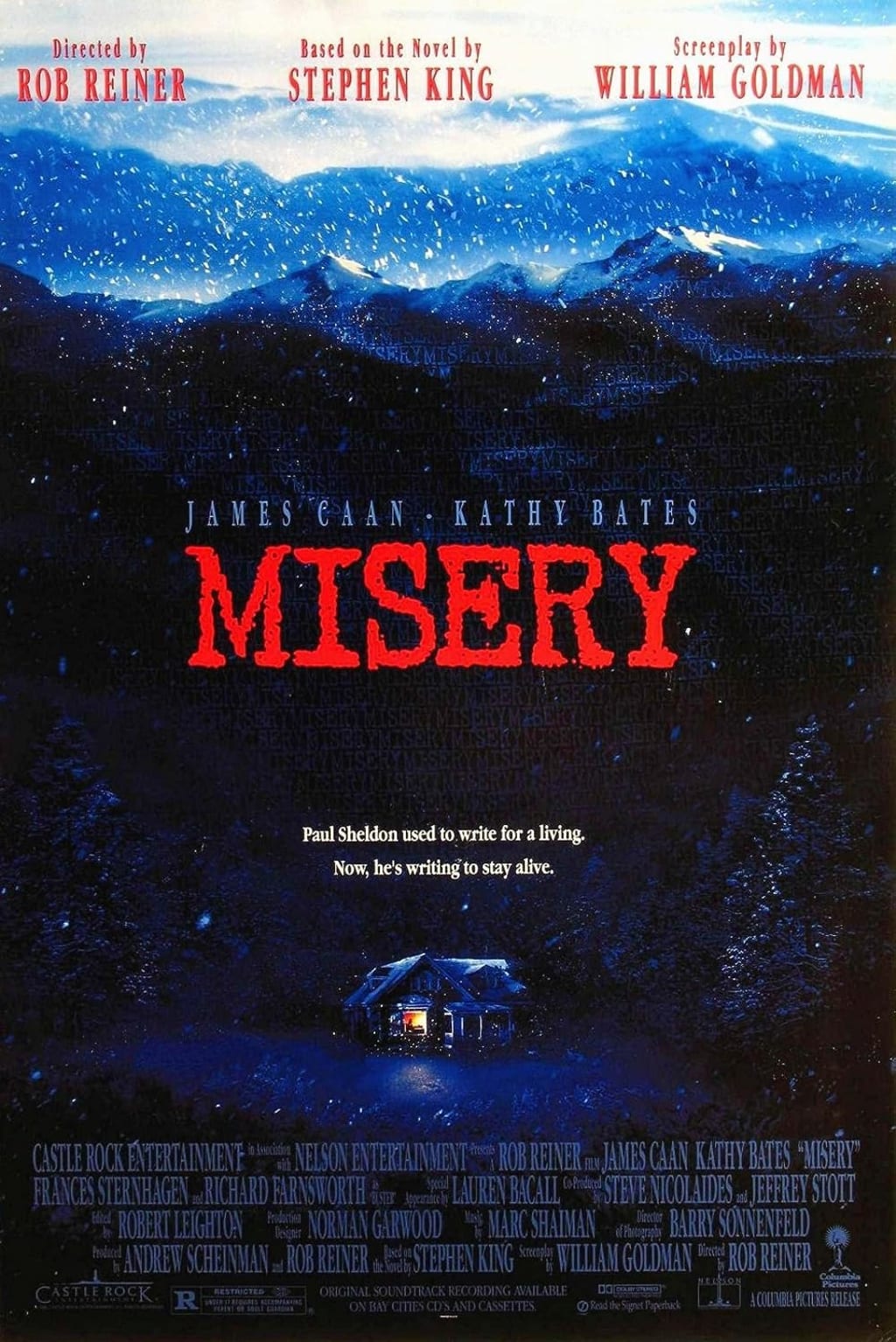Horror in the 90s: 'Misery'
Misery is quite entertaining for what it is.

Misery (1993)
Directed by Rob Reiner
Written by William Goldman
Starring James Caan, Kathy Bates
Release Date November 30th, 1990
Box Office $61.3 million
The first images seen on screen in Misery are utterly meaningless. A Lucky Strike cigarette, unlit, an empty champagne glass, and a bottle of Champagne. Visually, you can read into this a celebration about to occur. Indeed, the subject of Misery, writer Paul Sheldon, played by James Caan, is about to finish typing the final words of his final novel featuring the character Misery Chastain. Paul has decided to end his highly successful franchise and the opening visuals of the movie are an indication of the celebratory nature of this decision.
But what do these images foreshadow for the remainder of the story? Nothing really. Paul Sheldon will soon be involved in a car wreck. He will be rescued by someone who just happens to be 'his biggest fan.' Annie Wilkes (Kathy Bates), the fan, finds his novel and is none too pleased to find that her favorite book character is being killed off. Thus, she sets to set the author straight. She will hold him captive and torture him in order to get him to write a different, happier book, one more fitting her vision of Misery Chastain as her favorite book character.
In the context of a novel, it's very clear that Stephen King is commenting upon the fickle nature of readers and their relationship to authors. King, whether he openly acknowledged it or not, was truly writing about having been pigeonholed and seemingly forced to write to the tastes of his readers rather than to what spoke to him as an author and artist. That subtext is underlined in the novel form. As a movie, it doesn't resonate quite as much. We can get a sense of the commentary occurring, but this is a movie, not a novel, moreover it's an adaptation of Stephen King and not King himself sub textually crying out at his audience to let him choose his subjects.
For a movie, this thesis statement, author versus audience, if that is what they are making a movie about, should have some kind of reference in the visual presentation. Instead, the opening of Misery is rather inert in presentation. It's indicative of something but it is merely presentation, there is nothing to indicate what is to come, only what is happening immediately, in the moment. Paul is finishing his book and will celebrate before the actual plot kicks in, and the real story begins to unfold. There is nothing wrong with this but it's not a very exciting or particularly artful start to a movie.
The following transition scene is strange and needless. Paul goes to his car and places the satchel with his completed novel on the front seat of his muscle car. Middle aged men in 1990s movies always drive muscle cars, either Corvettes or Mustangs. In this case, it's a Mustang. He drives this because it's cool looking and he assumes the cool of the vehicle by driving it. We establish in this movie a snowstorm, one that has recently passed over Paul's location. Paul throws a snowball at a tree and states that he 'still got it.' Whatever that means. If this is intended to imply that Paul was once an athlete, how does this play into the rest of the movie? It doesn't. Nor does the car.
For reasons again of Boomer nostalgia and adopted cool, Paul starts driving to the tune of Shotgun by Jr. Walker and the All Stars. Why? No reason, a lot of people just like this song. I like this song. It's an all timer of a song. But why is it here? Rob Reiner is showing that he has zero care for details. It's all elementary aesthetics, it's all adopting the cool of other things. Is that perhaps what the deeper meaning is? Paul is the assumed cool of a generation desperately trying to prove their coolness. Will his encounter with his biggest fan force him to find himself, the real Paul Sheldon? I would love that, but sadly, I think this is all just pretext to getting Paul to where the plot is happening.
Paul very stupidly drives his way into a snowstorm. He arrogantly didn't check the weather before leaving and when it started to come down, he didn't slow down. Is this another character trait of Paul's being demonstrated or just another functional aspect of the plot of Misery? The story needs Paul to be in this accident in order to be rescued by Annie so she can discover his finished book and demand that he changes it or else. It's all very functional and it speaks to something I have long discussed on the Everyone is a Critic Movie Review Podcast. The difference between an artist and a carpenter when it comes to directing.
This is not a definitive categorization. Many directors have delivered sturdy films that lack artistry and then created a work of staggering beauty. It's not meant to doom a director or overly praise another director. It is, however, a strong descriptor for style and approach to directing. In essence, a director as Carpenter is one who is capable of assembling pieces and making them look presentable. The Carpenter knows how to follow schematics and deliver the idea before them in a fashion that is functional. Carpenters are hired specifically to build something that functions as it should.
An artist however not only succeeds in construction, but they also succeed in transcending construction. They don't stop at making something functional, they seek to make it something more. They make beauty, their images contain truth and their writing or their interpretation of the writing of others, transcends the mere instructions of a screenplay. An artist knows how to layer metaphor into visual language. They don't settle for mere presentation; they want every precise detail to matter to the viewer. Even something as simple as a song choice in a driving scene can say something about the character, the story, it can foreshadow, it can complement the scene.
A carpenter, for example, might use the song Shotgun by Jr. Walker and the All Stars simply because they like the song. An artist who sets out to make a movie with purpose, however, might choose a song that expresses the theme of the scene or the themes of the movie. Or the song choice could be a comic observation of the character or the moment. The thrust of my point is, that an artist cares about this detail and lives for an audience that will recognize and be delighted or feel a sense of connection in recognizing why the song is there. Rob Reiner as a director, is a carpenter. He's here to construct the pieces of William Goldman's adaptation of Stephen King's novel in a functional fashion that may or may not be a good movie.
If you are thinking to yourself that Annie does use a 'Shotgun' later in the movie, you're reaching desperately. There is no visual or even dialogue relationship between this song choice and Annie using a shotgun to murder the local sheriff played with wonderful local flavor by Richard Farnsworth. Reiner just like the song Shotgun and used it in this early scene as an adopted totem of good taste. Paul Sheldon likes good music. It's a character trait but not one that says more about him than, he likes good music.
You're probably assuming from this take on Rob Reiner as a director that I dislike Misery. That's not the case. As much as the direction is rather rudimentary, the acting is in fine shape. Kathy Bates, in particular, gives incredibly unique life to Annie Wilkes. The set pieces that arrange her villainy work because Bates is so deeply committed to them. She brings an energy and exhilaration to her villainous work that is darkly comic and unpredictable. The jarring shifts in her manner, the way the temperature of a scene changes slowly due to her mood, it's an undeniably brilliant piece of acting that elevates the movie she inhabits.
James Caan is far less interesting but that is somewhat by design. He's not asked to do much and he's mostly there to provide a sort of blank foil to Bates' insanity. We see her better without him trying to compete with her for our attention. His complete lack of showiness, his willingness to be the catalyst for what she is doing, actually works perfectly for the character and the movie. Misery may not have begun life as a vehicle for Bates' memorable work, but it most assuredly became that as the movie was being made and Caan appears to be one of the few to recognize that and work off of it.
That's the strength of Misery, Caan's willingness to support and motivate Bates. His generosity as an actor to recognize that she's giving so much, and he needs to not get in her way. It's genuinely impressive all these years later and given Caan's reputation as an egotist and tough guy. A reputation based more on his most famous performances than on anything tangibly true about James Caan the man. If I were to judge James Caan solely based on his performance here, I would say he was generous, self-effacing, and certainly not an egotist.
He provides brilliant support for Kathy Bates; a lesser actor would not have allowed themselves to be so overshadowed. Caan doesn't seem to see it as being overshadowed. He knows how good he is, and he knows that what he's doing is what is best for the movie, providing her with the energy and the counter to her insanity. He takes a celebrity character and renders him relatable in a performance that reflects the instinctive way anyone might approach a situation this strange and yet specific. Caan is giving Bates everything she needs to craft her remarkable, Academy Award winning performance.
Does Misery fall into the horror genre simply because of its origin in the work of Stephen King? Perhaps. Misery is certainly not a traditional horror movie. It does have a horror trope near the end when Annie pops back up after being thought dead, but beyond that, we're watching a two-hander thriller, an unwitting battle of wits between someone not fully of her faculties and a sly, crafty survivor who uses his wits to their full extent. It's blunt force versus finesse and that dynamic is very cleverly played out in Misery.
That is part of what I can credit Rob Reiner for. For what he lacks in directorial finesse and artistry, he does recognize how this material is best served. It's unshowy, it's about creating space for Bates and Caan and crafting the set they need to elevate the material. Reiner reflects a bit of the generosity of Caan's performance in how he settles for a basic set up and payoff structure. He likely could see the strength of the script and set about creating the most efficient way for that script to unfold. It's pure carpentry but it does create a sturdy base for its actors and in that way, Misery does work, even as it remains not a great work of art but a well assembled piece of entertainment.

This lengthy dissertation on Misery is a serialized portion of my book project, Horror in the 90s. I am sharing pieces on the movies I am covering for the book and inviting you to help me complete the book as a whole. You can do this by making monthly pledge or leaving one-time tips on Vocal. You can also commission me to write about a movie on my Ko-Fi page. For $10 dollars I will write about the movie of your choice. I can't promise positive or negative, but I will make it as entertaining and informative as possible. Thanks!
About the Creator
Sean Patrick
Hello, my name is Sean Patrick He/Him, and I am a film critic and podcast host for the I Hate Critics Movie Review Podcast I am a voting member of the Critics Choice Association, the group behind the annual Critics Choice Awards.






Comments (1)
This was very interesting! I never thought about the "artist vs. carpenter" thing before, but it makes total sense.